Outline of the Audio Stations, Contributors and Literature
On the following pages, the “listening stations” are presented individually: the contemporary witnesses and experts, speakers and musicians are named, photos show the work in the studio. The presentation of the listening stations is followed by a complete bibliography for the respective chapter:
The audio stations are listed in alphabetical order, however, you may also access them directly by clicking on the name of the station:
AMERICA, CHRISTMAS, COURAGE, DREAM, EVERYDAY LIFE, FAIRYTALE, GIFT, HUH!!, KISS, MILK, NO!, PARTY, PHOTO, PISSED ON, POWER, REGARDLESS, RUBBER, SHARDS, SPECIAL TRIP, STARS, SUBMARINE, SUIT, SUSPICION, TODAY!, WITHOUT ME!, YOU’RE NUTS!
The texts were translated from the German version. All of the original quotes by contemporary witnesses were reproduced in English. The audio stations are authored by Hans Ferenz (unless stated otherwise), the translation was done by John C. Barry, and the copy editing by Ekpenyong Ani.
The description of the audio stations is followed by a list of references.
AMERICA
Three audio stations feature readings of excerpts from the young-adult novel “Julians Bruder” (Julian’s Brother), written by Klaus Kordon. The main protagonists, Paul and Julian, are true friends: they live in Berlin Mitte, in the same building, attend the same class at school. When the National Socialists come to power, certain problems arise because Julian is Jewish and Paul isn’t.
In this scene of the novel, Paul is sitting on the banks of the river Spree wishing for his best friend to be able to emigrate to America. Julian must live, he mustn’t die at the hands of the National Socialists. But only few Jews succeed in leaving the country. (Duration 5:35 minutes)
Speakers:
Jano Franke (Paul), Tom Schilling (Speaker), Christian Soglo (Jule).
Authors:
Hans Ferenz, Klaus Kordon
Resources/References:
Böhmann, Marc,2008
Bundesamt für Migration und Flüchtlinge, 2008
Jugendgeschichtswerkstatt, 2008
Kordon, Klaus, 2004
CHRISTMAS
On Christmas Eve of the year 1941, Dr Ruth Gross was twelve years old. Her parents decided to attend the church service on this festive occasion in the nearby church of St. Sophia – with the new yellow Star of David pinned to their chests. “I think my father just wanted to see how Christians, celebrating the birth of Jesus the Jew, would react when a couple of Jews turned up to take part in the celebrations.“ An original quote. (Duration 2:30 minutes)
Speaker:
Elisabeth Trissenaar (Dr Ruth Gross)
COURAGE
This is almost like a stage play on Otto Weidt and his “Workshop for the Blind for Brooms and Brushes” where he hid Jews from the National Socialists and helped them out with papers, food, clothes and most of all with courage and humanity. With the contemporary witness Inge Deutschkron. (Duration 6:57 minutes)
Speakers:
Claudia Balko (worker), Michaela Hanser (worker), Daniel Jeroma (worker), Hansi Jochmann (Inge Deutschkron), Dietrich Lehmann (Dietrich Lehmann), René Schubert (inspector)
Resources/References:
Deutschkron, Inge, 2006
Ludwig, Volker u. Michel, Detlef, 1989
Museum Blindenwerkstatt Otto Weidt, 2007
Rewald, Ilse, 2001
Schieb, Barbara; Voigt, Martina, 1998
Interview with contemporary witness
DREAM
On November 9th, 1938, smoke was also rising from the synagogue on Oranienburger Straße. Slogans were blaring from the wirelesses, announcing the demise of Jewish culture and religion. 70 years later, Jewish life is once again thriving in Berlin Mitte. However, scars remain.
In their hip-hop music, the musicians “Zeugen der Zeit” (witnesses of time) dream of an “everyday coexistence” – together with cantor Avitall Gerstetter. (Duration 5:05 minutes)
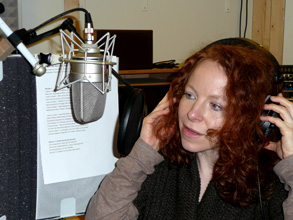
Avitall Gerstetter (cantor) sings the chorus in German and Hebrew
Music:
Dream, Zeugen der Zeit, T+K: Band, Vocals: Band and Avitall Gerstetter (cantor)
Resources/References:
Blätter der Wohlfahrtspflege, Deutsche Zeitschrift für Soziale Arbeit 2008
Boie, Johannes, 2008
Heydrich, Reinhard, 1938
Wetzel, Juliane, 2006
EVERYDAY LIFE
Kristina Schoubyé is 21 years old. She is studying to be a media designer. When her grandmother, Inge Schoubyé, was 14 years old, she was an apprentice here in Auguststraße 63, at the corner of Kleine Hamburger Straße, in her aunt’s hairdressing salon: inside they were putting hair on rollers, outside there was the war. A juxtaposition. (Duration 5:33 minutes)
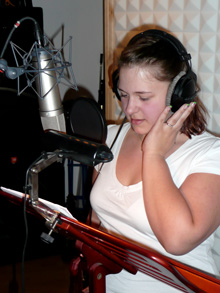
Kristina Schoubyé: “The things that my Grandma experienced… I can well do without.”
Speakers:
Claudia Balko (Inge Schoubyé), Lena Engelmann (Kristina Schoubyé)
FAIRYTALE
Time and again, right wing extremists try to glorify the atrocities of the National Socialists or to ascribe them to the realm of fairytales. This is an “anti-fairytale” – with accounts of the contemporary witnesses Frieda Gottesmann (of blessed memory) and Inge Link as well as scenes played by teenagers. (Duration 6:31 minutes)
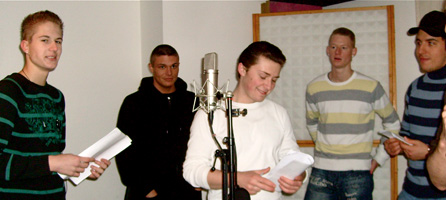
Speakers:
Hartmut Becker (narrator), Michaela Hanser (Frieda Gottesmann), students from Albert-Schweitzer secondary school (teenagers), Gudula Tietze-Lindemann (Mrs Link)
Resources/References:
Daniels, Arne, 2008
Epstein, Rob u. Friedman, Jeffrey, 2006
Friedrichsen, Gisela, 2003
Gaschke, Susanne, 2005
Harpprecht, Klaus, 2005
Report Mainz/SWR, 2008
Schule ohne Rassismus, 2008
Spiegel Online, 2007
Wetzel, Juliane, 2006
Wittrock, Philipp, 6/2008
Interviews with contemporary witnesses
GIFT
The former “Jewish old people’s home” was situated in “Große Hamburger Straße”. It was misused by the National Socialists as a collection camp for Jews prior to their deportation. Isaak Behar (of blessed memory) was also supposed to be taken to Auschwitz from here. He was 19 years old. (Duration 5:47 minutes)
Speakers:
Hartmut Becker (Isaak Behar), Michaela Hanser (Hanna), Murat Topal (Murat), Jörg Westphal (soldier)
Resources/References:
Behar, Isaak, 2006
Gottwaldt, Alfred u. Schulle, Diana, 2005
Jah, Akim, 2007
Rosenstrauch, Hazel, 1991
Interview with contemporary witness
HUH??
This is an account dealing with the question if the Germans knew about the deportation and murder of the Jews at the time or if they could have known. The location of this audio station is the memorial to the deported Jews “Der verlassene Raum” at the north end of Koppenplatz. (Duration 6:45 minutes)
Speakers:
Claudia Balko (passer-by), Megan Gay (journalist Kardorf), Michaela Hanser (woman at the window, WC-attendant), Klaus Hoser (passer-by), Daniel Jeroma (soldier), Hansi Jochmann (passer-by), Dietrich Lehmann (civil servant, soldier), Josephine Schmidt (journalist Friedrich), Jörg Westphal (Graf von Moltke)
Resources/References:
Dörner, Bernward, 2007
Harpprecht, Klaus, 2005
Landesjugendring Berlin, 1997
Liebmann, Irina, 2002
Sparkassen-Kulturstiftung, 2002
KISS
Even though having contact with Jews was forbidden, there was many a flirt and true love among Aryans and non-Aryans. Contemporary witnesses talk about first kisses – and it didn’t always stop there. In the past, just as today, love can’t be bothered with questions of faith – one would imagine. (Duration 5:28 minutes)
With the contemporary witnesses Isaak Behar (of blessed memory), Ruth Winkelmann, Ursula Zobel and statements teenagers made during surveys in Berlin.
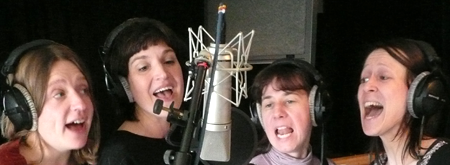
The group “aquabella” during vocal recordings: “… if you prostrate yourself to pray, or burn incense every day – makes no diff-erence to a kiss…“
Speakers:
Jade Ara (girl in stairwell), Claudia Balko (Ruth Winkelmann), Hartmut Becker (Isaak Behar), Michaela Hanser (Ruth Zobel), Daniel Jeroma (boy in stairwell), students from Albert Schweitzer secondary school, Jewish secondary school, Martin Buber secondary school
Music:
Uwe Janßenharms, to the tune of: “So ein Kuss kommt von allein”, Comedian Harmonists, K: Grothe Franz, T: Dehmel, Willy – Beboton-Verlag Hamburg, GEMA: 1194871- 001
Vocals:
Aquabella (Bettina Stäbert, Claudia Carduck, Bérangére Palix, Maria Tomaschke)
Resources/References:
Boie, Johannes, 2008
Schule ohne Rassismus, 2008
Spiegel Spezial, 2008
Interviews with contemporary witnesses and surveys
MILK
A musical, human, humorous portrayal of the multi-religious daily routine in the catholic hospital of St. Hedwig – with a “factual report” by Sister Gunthilde. (Duration 2:05 minutes)
Vocals:
Aquabella (Bettina Stäbert, Claudia Carduck, Bérangére Palix, Maria Tomaschke)
To the tune of:
”Ein kleiner grüner Kaktus”, Comedian Harmonist, K: Marcuse, Reisfeld, Universal Publ. Germany, GEMA: 744493-002
NO!
Early in the morning of February 27th, 1943, the “final campaign Berlin Jews” began: all over the city the remaining Jews were arrested and transported to one of the six collection camps in town, Berlin should finally be “cleansed of Jews”. One of the collection camps was the building of the former Jewish Administration Office in Rosenstraße 2-4. That is where roughly 2000 Jewish men married to “Aryan” women were specifically taken.
In the days that followed, the “Aryan” women, children and their relatives gathered in front of the collection camp Rosenstraße: partly to observe what was going on, and partly to shout out demands for the release of their husbands and fathers.
The account of a protest – for drums and speaker, with the contemporary witness Dr Ruth Gross. (Duration 6:14 minutes)
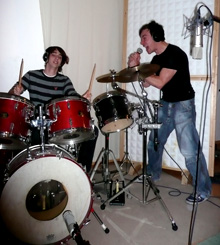
Voice against drums: recording of the audio station NO!
Speakers:
Daniel Jeroma (Speaker), Elisabeth Trissenaar (Dr Ruth Gross)
Drums:
Jano Franke
Resources/References:
Benenowski, Hans, 1983
Der Spiegel, 1993
Gruner, Wolf, 2005
Jochheim, Gernot, 2002
Sandvoß, Hans-Rainer, 1999
Sandvoß, Hans-Rainer, 2000
Schoeps, Julius H.,1984
Wiebel, Martin, 2003
Interview with contemporary witness
PARTY
In those days, with the National Socialists, it worked well enough: popular hiking songs became military marches for the soldiers. Everyone could join in right away – in the joyful march into war. Today, neo-Nazis attempt to make their misanthropic message popular among young people by packaging it as party music. A “radio play report”. (Duration 6:26 minutes)
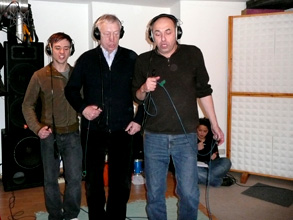
Scene for the audio station: “Soldiers in lockstep” singing and marching past the microphone
Speakers:
Jade Ara (woman on the roadside), Claudia Balko (Ruth Bökler), Hans Ferenz (soldier), Herbert Grönemeyer (presenter), Michaela Hanser (Ruth Zobel), Daniel Jeroma (soldier), Dietrich Lehmann (soldier), Ewald Pfleger (Ewald Pfleger, group “Opus”), students from Martin-Buber secondary school (party scene), Gudulla Tietze-Lindemann (Mrs Link)
Resources/References:
Agentur für soziale Perspektiven e.V., o.J.
Antifaschistisches Pressearchiv und Bildungszentrum Berlin e.V. (APABIZ), 2002
Jacke, Christiane, 2008
Schröm, Oliver, 2006
Staud, Toralf, 2006
Stiftung Schloss Neuhardenberg, 2006
Wetzel, Juliane, 2006
Interviews with contemporary witnesses
PHOTO
When Frieda Gottesmann was standing in Auschwitz at 20, her family had long been deported and murdered by the National Socialists. In her pocket she carried the last photographs with her. Precious memories. “And yet I was forced to throw them away, because the soldier said to me: ‘If you don’t throw that away right now then I’ll shoot you’.”
Years later she by chance got hold of pictures from the time she went to school, one of them a class photo: All of the pupils were dead, murdered by the National Socialists. An audio station about the importance of and dealing with memories.
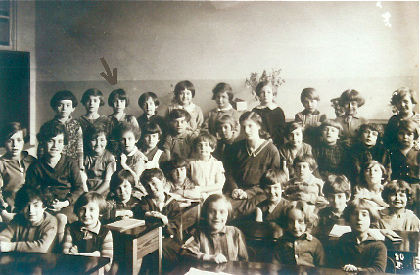
Speakers: Students from Berlin and Frankfurt/Oder: Jano Franke, Johanna Herlebach, Ali Kizilkaya, Ana-Rita Lauer, Christian Soglo
Resources/References:
Interview with contemporary witness
PISSED ON
Three audio stations feature readings of excerpts from the young-adult novel “Julians Bruder” (Julian’s Brother), written by Klaus Kordon. The main protagonists, Paul and Julian, are true friends: they live in Berlin Mitte, in the same building, attend the same class at school. When the National Socialists come to power, certain problems arise because Julian is Jewish and Paul isn’t.
The scene from the novel read here describes an incident which occurred in early September, 1941: Jews have to wear a yellow Star of David, they are now recognisable and are publicly humiliated.
Students from “Edith Stein secondary school” in Prenzlauer Berg and “Martin Buber secondary school” in Spandau relate similar incidents with neo-Nazis in the past years. They classify and comment on them. (Duration 5:49 minutes)
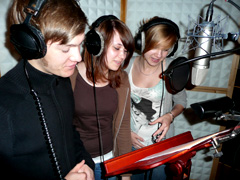
Students from Martin Buber secondary school in the studio
Speakers:
Jano Franke (Paul), Tom Schilling (speaker), Christian Soglo (Jule), Students from Martin Buber secondary school
Authors:
Hans Ferenz, Klaus Kordon
Resources/References:
Böhmann, Marc, 2008
Friedrichsen, Gisela, 2003
Gaschke, Susanne, 2005
Kordon, Klaus, 2004
Netzwerk für Demokratische Kultur e.V., 2006
Rafael, Simone, 2003
Wittrock, Philipp, 6/2008
POWER
A report on the employees of the former Department for Jewish Affairs who planned the deportation of Berlin’s Jews to the concentration camps: it deals with their self-conception, their involvement, their lies in court, their consciousness of guilt. (Duration 7:17 minutes)

Axel Prahl lends his voice to the policeman Karl Becker, based on the transcript of the court proceedings: “And if someone says that I should have known it, because it was in all of the National Socialist books and magazines, then…, well, then I can only say to that, that I wasn’t familiar with the literature of the party… on the other hand, then every reader in the whole world would have had to know, everyone back then, all of them, not just me.”
Speakers:
Thomas Ahrens (pliceman Lachmuth) Megan Gay (presenter), Axel Prahl (policeman Becker), Jörg Westphal (policeman Rothe)
Resources/References:
Aly, Götz, 2006
Daniels, Arne, 2008
Helas, Horst, 2001
Jah, Akim, 2007
Jah, Akim, 2008
REGARDLESS!
A collage of music and words about the Jewish secondary school and about the question why students attend this school despite the fence, the surveillance cameras and the security officials. All of the sounds and the music were produced orally by the musicians of the beatboxing group “4XSamples”. (Duration 3:20 minutes)
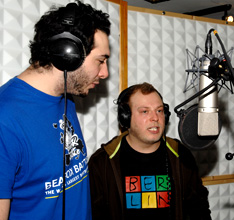
4XSamples in the studio (f.l.): Mando, Phil; photo: Bernd van Meer
Speakers and musicians:
4XSamples (Mando, Phil) and students from the Jewish secondary school
RUBBER
At the beginning of the 20th century the Jewish family Fromm lived in very poor circumstances in Mulackstraße in Berlin. However, Julius Fromm, second of three children, went to night classes in rubber chemistry and invented the seamless condom – an invention that was needed and still is. Everywhere and across cultures. A subtle and humorous “radio show”. (Duration 6:15 minutes)
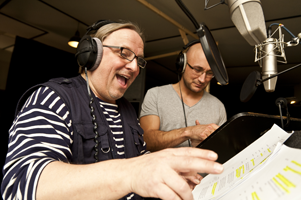
Having fun with condoms: Axel Prahl and Murat Topal as speakers of the “radio show”
Speakers:
Murat Topal (Murat), Axel Prahl (Axel Prahl), Students from Martin Buber secondary school
Music:
Resources/References:
Aly, Götz, u. Sontheimer, Michael, 2007
Biggeleben, Christof; Schreiber, Beate; Steiner, Kilian, 2007
SHARDS
In February 1939, three months after Pogrom Night, the Jewish merchant Isidor Tikotzki left Berlin Mitte for the United States, leaving behind his destroyed and looted shop for underwear and bed linen in Alte Schönhauser Straße. In September 2003, six months after neo-Nazis have broken the window of his corner shop, the Jewish merchant Noah* leaves Berlin Reinickendorf for Israel. A report.
Complemented by statements from students from the Jewish secondary school and Martin Buber secondary school.
Speakers:
Thomas Ahrens (Noah), Megan Gay (speaker), Daniel Jeroma (Tikotzki’s son), Jörg Westphal (man in shop), Michaela Hanser (Frieda), students from Martin Buber secondary school (teenagers)
Music:
Charleston, The World of Charleston, ZYX-Music GmbH&Co KG, LC 6350; Fly Away, T+K: Lenny Kravitz, © 1998 Virgin Records America Inc., LC 03098
Resources/References:
Daniels, Arne, Hamburg 2008
*Dehne, Anja, Berlin 2003 (Beitrag in „Kontraste“/rbb: Aus rechtlichen Gründen konnten die Originaltöne nicht verwendet werden)
Der Spiegel, 29/1992
Deutschkron, Inge, 2001
Helas, Horst, 2001
Heydrich, Reinhard, 1938
SPECIAL TRIP
In Große Hamburger Straße the former Jewish old people’s home was misused as a “collection camp for Jews”. Jews from all over the city were brought here before being transported to Theresienstadt in closely-guarded groups. The trip to the concentration camp began with boarding a tram of the BVG (Berlin public transport system) at the turning loop in Oranienburger Straße/Große Präsidentenstraße. A report supplemented by research findings of the historian Alfred Gottwald. (Duration 5:35 minutes)
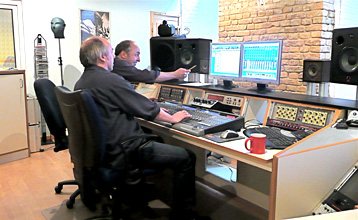
Working on the audio stations
Speakers:
Thomas Ahrens (policeman Lachmuth), Claudia Balko (woman in tram), Megan Gay (speaker), Michaela Hanser (woman in tram), Daniel Jeroma (soldier), Stephan Rumphorst (Alfred Gottwald), Jörg Westphal (soldier)
Resources/References:
Gottwaldt, Alfred u. Schulle, Diana, 2005
STARS
In September 1941, Günter Jochmann, thirteen years old at the time, strolled from the S-Bahn train station “Börse” (“Hackescher Markt” today) to the toy shop “Keilich”. Walking the distance of about three hundred metres, he counted “roughly forty stars” on the clothes of Jews – six months later there were only three or five … (Duration 4:10 minutes)
Speakers:
Klaus Hoser (Günter Jochmann), Axel Prahl (speaker), Vera Schlenker (mother)
Resources/References:
Gottwaldt, Alfred, 2008
Interview with contemporary witness
SUBMARINE
2000 Jews survived Nazi Germany in Berlin as “submarines”: “submerged” with false names, false passports, hidden in cubbyholes without daylight or somewhere among the ruins of the city. Many helpers were needed to organise food, clothes and even medication in emergencies. An account with the contemporary witness Michael Degen.
Speakers:
John C. Barry (Michael Degen), David Kross (Speaker)
Authors:
Michael Degen, Hans Ferenz
Resources/References:
Benz, Wolfgang, 2003
Degen, Michael, 2007
Degen, Michael (Hörbuch) 2009
Deutschkron, Inge, 2001
Deutschkron, Inge, 2006
Harpprecht, Klaus, 2003
Löhken, Wilfried u. Vathke, Werner, 1993
Lovenheim, Barbara, 2002
Rewald, Ilse, 2001
Schieb, Barbara; Voigt, Martina, 1998
Schönhaus, Cioma, 2008
SUIT
For many young people, becoming independent starts with a shared flat where partying is guaranteed. For 91-year-old Anni Wolff (of blessed memory) it was quite similar back in the day – and yet very different: in shared flats young Jews were waiting for their exit permit to leave Nazi Germany for Palestine. But nevertheless: “We were young, we wanted to have fun.” (Duration 5:04 minutes)
Speakers:
Claudia Balko (mother), René Schubert (father), Josephine Schmidt (narrator), Michaela Hansa (Anni Wolf)
Music:
Title: “ungezogen angezogen”, group: The Munchies
Resources/References:
Harpprecht, Klaus, 2003
Rosenstrauch, Hazel, 1991
Wolff, Anni, 1993
Interview with contemporary witness
SUSPICION
When the National Socialists were in power, a “housing-block supervisor” wasn’t just a caretaker: he was a “representative of the Führer” in the block of houses. He had power. He collected donations for the party. He would check with the parents if their son or daughter didn’t greet with the proper Hitler salute.
And if in those days there had already been teenagers hanging out on the streets with headphones, a proper German housing-block supervisor would probably have addressed them suspiciously:
„Excuse me? Headphones is what they are? Headphones, never heard of them. Have they been approved by the ministry for Reich-Propaganda? Headphones, no, I can’t imagine our esteemed minister Joseph Goebbels allowing people to phone with their heads. People who use their heads are highly suspicious.“
Author:
Martin Buchholz
Speakers:
René Schubert (housing-block supervisor)
Resources/References:
Helas, Horst, 2001
Landesjugendring Berlin, 1997
Ruckenbiel, Jan, 2001
TODAY!
This station deals with the end of the war at the entrance to the garrison cemetery (Garnisonsfriedhof) where in the very back there is a mass grave which was dug in the last days of the war. Several contemporary witnesses can be heard: Reinhart Crüger, Ursula Zobel, Irm Schulze as well as music by the group The Munchies (Duration 7:26 minutes)
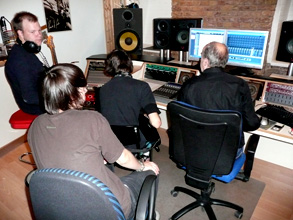
“The Munchies” in the studio “track@once” – putting the finishing touches to their song “Today!”; audio engineering and production: Uwe Janßenharms (right)
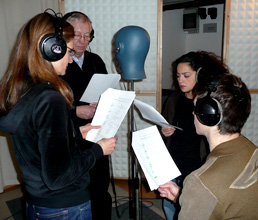
Dummy head recordings for a word collage
Speakers:
Claudia Balko (Irm Schulz, collage), Hartmut Becker (Reinhart Krüger), Michaela Hanser (Ursula Zobel, collage), Daniel Jeroma (collage, young man by the mass grave), Dietrich Lehman (collage, old man by the mass grave, old man by the cemetery entrance), students from Martin Buber secondary school (news)
Musicians:
The Munchies: Benni (voc German version, g), Bertram Schemel (voc. English version) Jano (dr.), Nicolai (g), Yunos (b)
Music:
”Fang an!/Today!”, The Munchies; lyrics: Hans Ferenz, The Munchies; composition: The Munchies
Resources/References:
Landesjugendring Berlin, 1997
Deutsche Rotes Kreuz – Liste der im Massengrab beigesetzten Personen
Metaversa, 2007
Interviews with contemporary witnesses
WITHOUT ME!
Three audio stations feature readings of excerpts from the young-adult novel “Julians Bruder” (Julian’s Brother), written by Klaus Kordon. The main protagonists, Paul and Julian, are true friends: they live in Berlin Mitte, in the same building, attend the same class at school. When the National Socialists come to power, certain problems arise because Julian is Jewish and Paul isn’t.
It’s just before the end of the war – as the reading goes – and 16-year-old Paul is conscripted to the German army. Armed with an anti-aircraft gun he is supposed to shoot attacking aircrafts down from the sky – after all, Berlin must be defended to the last man. But Paul doesn’t want to be the last man to die. He takes off his uniform jacket and runs away… (Duration 8:28 minutes)
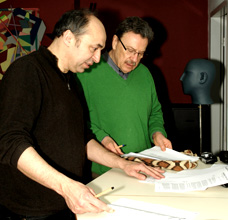
(f.r.): Writer Klaus Kordon and Hans Ferenz, author of the audio station, in the recording studio: shortly before recording they discuss final changes to the manuscript (photo: Bernd van Meer)
Speakers:
Jano Franke (Paul), Tom Schilling (narrator), students from Martin Buber secondary school and Albert Schweitzer secondary school (teenagers)
Authors:
Hans Ferenz, Klaus Kordon
Resources/References:
Böhmann, Marc, 2008
Kordon, Klaus, 2004
YOU‘RE NUTS!
The story of the swing musician Coco Schumann who was 19 when he was deported to Theresienstadt and Auschwitz and only survived because he was a member of the camp music-band and “allowed” to play in front of the gas chambers. (Duration 7:03 minutes)
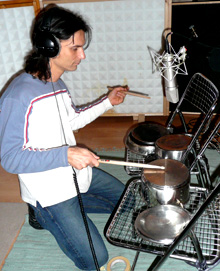
Coco Schumann first learned to play the drums playing on pots at home. Drummer Mattes Leon (Alphaville) plays the sounds to match the story.
Speakers:
Klaus Hoser (Coco Schumann), René Schubert (camp overseer)
Studio musicians:
Mattes Leon (dr), Uwe Janßenharms (g)
Music:
”Im Himmel spielt auch schon die Jazzband”, composition: Kálmán, Emmerich, lyrics: Brammer, Julius, Gruenwald, Alfred – Octava Music Australia, GEMA: 574810-001; “The Flat Foot Floogee”, lyrics and composition: Slim Gaillard, Slam Stewart, Bud Green – EMI Music Publ. Germany, LC10145
Resources/References:
Denk, David u. Hüttl, Tina, 2006
Rosenstrauch, Hazel, 1991
Schumann, Coco, 2005
Stiftung Schloss Neuhardenberg, 2006
Interview with contemporary witness
References
Agentur für soziale Perspektiven e.V. – asp (Hg.): Willy-Brandt-Haus-Materialien, Versteckspiel: Lifestyle, Symbole und Codes von neonazistischen und extrem rechten Gruppen, Berlin o.J.
Antifaschistisches Pressearchiv und Bildungszentrum Berlin e.V. (APABIZ) (Hg.): White Noise. Begleitmusik zu Mord und Totschlag, Materialien zur Veranstaltung, Berlin 2002
Aly, Götz: Hitlers Volksstaat. Raub, Rassenkrieg und nationaler Sozialismus, Frankfurt am Main 2006
Aly, Götz, u. Sontheimer, Michael: Fromms. Wie der jüdische Kondomfabrikant Julius F. unter die deutschen Räuber fiel, Frankfurt am Main 2007
Behar, Isaak: Versprich mir, dass du am Leben bleibst. Ein jüdisches Schicksal, Berlin 2006
Biggeleben, Christof; Schreiber, Beate; Steiner, Kilian (Hg.): „Arisierung“ in Berlin, Berlin 2007
Benenowski, Hans: Nicht nur für die Vergangenheit. Streitbare Jugend in Berlin um 1930. Erzähltes Leben II, Berlin- Kreuzberg 1983
Benz, Wolfgang (Hg.): Überleben im Dritten Reich. Juden im Untergrund und ihre Helfer, München 2003
Beer, Mathias: Die Entwicklung der Gaswagen beim Mord an den Juden, in: Vierteljahrshefte für Zeitgeschichte (Hg.), 35. Jg / 3. Heft/ München 1987
Blätter der Wohlfahrtspflege, Deutsche Zeitschrift für Soziale Arbeit (Hg.): Islam. Kritische Kooperation erwünscht: Muslimische Vereine als Partner in der Sozialen Arbeit, Frankfurt am Main 4/2008
Bode, Sabine: Die vergessene Generation. Die Kriegskinder brechen ihr Schweigen, 3. Auflage, München 2005
Böhmann, Marc: „Julians Bruder“ im Unterricht, Lehrerhandreichungen zum Jugendroman von Klaus Kordon, in: Materialien für einen handlungs- und produktorientierten Literaturunterricht, Praxis Beltz, Weinheim und Basel 2008
Boie, Johannes: „Das geht direkt ins Hirn“. Comiclegende Art Spiegelman zeigte seine Arbeiten in Berlin- und stritt radikal für Meinungsfreiheit, in: Der Tagesspiegel vom 16.4.2008
Brüggemeier, Franz-Josef: Juden im deutschen Fußball, in: Bundeszentrale für politische Bildung (Hg.): Informationen zur politischen Bildung (Heft 290). Fußball – mehr als ein Spiel, Berlin 2006
Bundesamt für Migration und Flüchtlinge (bamf): Asyl in Zahlen, Nürnberg 2008
Daniels, Arne: Erinnerung. Wie sich der Umgang mit der Geschichte verändert, http://stern.de/politik/historie/:Kriegsende-Besiegt,-Deutschland-1945-48/538448.html?nv=ct_cb&eid=537265 , Hamburg, 21.3.2008
Degen, Michael: Nicht alle waren Mörder. Eine Kindheit in Berlin, 16. Auflage, Berlin 2007
Degen, Michael: Nicht alle waren Mörder / Hörbuch, Deutsche Grammophon, Hamburg 2009
Dehne, Anja: Bespuckt, Beleidigt, Boykotttiert – ein deutscher Jude gibt auf, in: RBB Kontraste vom 4.9.2003
Denk, David u. Hüttl, Tina: Interview mit Coco Schumann. “Ich griff eine Gitarre und spielte“, in: die tageszeitung, Berlin vom 16.5.2006
Der Spiegel 29/1992: Tagebuchschreiber Goebbels über die „Reichskristallnacht“, Hamburg 1992
Der Spiegel 8/1993: „Nur noch ein Schluchzen“ Ein vergessenes Kapitel aus der NS-Zeit: Vor 50 Jahren retteten protestierende Frauen in Berlin ihre jüdischen Ehemänner und Kinder vor der Deportation nach Auschwitz, Hamburg 1993
Deutschkron, Inge: Berliner Juden im Untergrund, in: Beiträge zum Widerstand 1933-1945, Gedenkstätte Deutscher Widerstand, Berlin 2001
Deutschkron, Inge: Offene Antworten. Meine Begegnung mit einer neuen Generation, Berlin 2004
Deutschkron, Inge: Ich trug den gelben Stern, München 2006
Dörner, Bernward: Die Deutschen und der Holocaust. Was niemand wissen wollte, aber jeder wissen konnte, Berlin 2007
Epstein, Rob u. Friedman, Jeffrey: Paragraph 175. Film, Berlin 2006
Frank, Heribert (Hg.): Und Gad ging zu David. Die Erinnerungen des Gad Beck 1923 bis 1945, 3. Auflage, München 1999
Frei, Norbert (Hg.): Hitlers Eliten nach 1945, München 2004
Friedrichsen, Gisela: „Sag, dass du Jude bist!“, in: Der Spiegel, 24/2003, Hamburg 2003
Gaschke, Susanne: Die Wut der Unterschicht. Der Fall Ronny B. oder: Warum verwahrloste Jugendliche in Ostdeutschland unvorstellbare Grausamkeiten verüben, http://www.zeit.de/2005/26/Nazis, vom 23.6.2005
Geißler, Cornelia: Puzzle der Erinnerung. Regina Scheer über die Gruppe um Herbert Baum, in: Berliner Zeitung vom 10.11.2004
Geo Epoche Nr. 20: Die Geschichte des Judentums, 3000 Jahre Glaube und Kultur: Von König David bis zur Gründung des Staates Israel, Hamburg 2005
Gerstetter, Avitall u. Lembert, Wilfried: Konzept für eine Mehrreligionenhaus in Berlin-Mitte, Auguststr. 14-16, Berlin 2008
Glindmeier, Mike u. Gerlach, Clemens: Dejagahs Länderspielabsage. Zentralrat empört über „privaten Judenboykott“, http://www.spiegel.de/sport/fussball/0,1518,510136,00.html, vom 8.10.2007
Goldmann, Sven: Vereinsfarbe: braun – weiß. Über die NS-Zeit schweigen sich viele Klubs aus. Und welche Rolle spielte Hertha unter Hitler? in: Der Tagesspiegel, Berlin vom 5.10.2007
Goldmann, Sven: Nicht mal ein Mitläufer. Herthas Idol Hanne Sobeck prügelte sich mit der SA und war der NSDAP nicht gut genug, in: Der Tagesspiegel, Berlin vom 2.12.2007
Gottwaldt, Alfred u. Schulle, Diana: Die Judendeportationen aus dem Deutschen Reich von 1941 – 1945, Wiesbaden 2005
Gottwaldt, Alfred: „Eilig, eilig, hin zu Keilich“ – Erinnerung an Bernhard Keilich. Das größte Spielwarengeschäft der Welt, in: Deutsches Technikmuseum Berlin 4/2008
Gruner, Wolf: Widerstand in der Rosenstraße. Die Fabrik-Aktion und die Verfolgung der „Mischehen“ 1943, Frankfurt am Main 2005
Harpprecht, Klaus: Zeitgeschichte. Gab es Nazis überhaupt jemals? 1945 oder die Entdeckung der deutschen Leere, http://www.zeit.de/2005/19/Nazis-Nazismus, vom 4.5.2005
Harpprecht, Klaus: Widerstand. Die Kraft des Anstands. Ein neues Buch zeigt: Es gab mehr Helfer für die verfolgten Juden im Dritten Reich als oft angenommen, http://www.zeit.de/2003/40/P-Benz, vom 25.9.2003
Helas, Horst: Juden in Berlin – Mitte, Biografien, Orte, Begegnungen, in: Verein zur Vorbereitung einer Stiftung Scheunenviertel Berlin e.V. (Hg.), 2. Auflage, Berlin 2001
Heydrich, Reinhard: Fernschreiben an alle Stapoleit- und Stapostellen… „Betrifft: Maßnahmen gegen Juden in der heutigen Nacht“, München 10.11.1938
Jacke, Christiane u.a.: Neonazis auf Kinderfang. Brauner Drill im Jugendlager, http://www.spiegel.de/schulspiegel/wissen/0,1518,569129,00.html, vom 31.7.2008
Jah, Akim: Vom Altenheim zum Sammellager. Die Große Hamburger Straße 26, die Deportation der Berliner Juden und das Personal der Stapoleitstelle Berlin, Manuskript, Berlin 2007
Jah, Akim: Methode „Polizisten“, Internes Papier, Berlin 2008
Jansen, Frank: Extrem gefährlich, http://www.tagesspiegel.de/zeitung/Fragen-des-Tages;art693,2531517, Berlin 2008
Jochheim, Gernot: Ruth Gross-Pisarek erinnert sich, in: Frauenprotest in der Rosenstraße Berlin 1943. Berichte- Dokumente- Hintergründe, Berlin 2002
Jugendgeschichtswerkstatt: Briefe von Hermann Samter, http://www. Jugendgeschichtswerkstatt.de/judenverfolgung/briefe.html, vom 18.4.2008
Keller, Claudia: Kantorin träumt vom Mehr-Religionen-Haus, http://www.tagesspiegel.de/berlin/;art270,1949276, vom 5.5.2007
Kellerhoff, Sven Felix: Geschichte in Geschichten: Ortstermin Mitte. Auf Spurensuche in Berlins Innenstadt, Berlin 2007
Kordon, Klaus: Julians Bruder, Weinheim und Basel 2004
Kotowski, Elke-Vera (Hg.): Juden in Berlin. Biografien, Berlin 2005
Kramer, Heide: Ein Apfel für Birgit Berkowitz, in: Kollektives Gedächtnis: Materialien zu Blockwart, Hannover 2004
Landesjugendring Berlin, Arbeitskreis politisch-historischer Stadtrundfahrten, Projekt ZeitzeugInnen aus der Spandauer Vorstadt: Die Spandauer Vorstadt 1933 bis 1945. Zeitzeuginnen erzählen. Eine Dokumentation, Berlin 1997
Landesjugendring Berlin: Berlin – Auf den Spuren deutscher Geschichte. Eine politisch-historische Stadtrundfahrt zum Thema Nationalsozialismus für Jugend- und SchülerInnengruppen und andere Interessierte, Berlin 2003
Liebmann, Irina: Stille Mitte von Berlin. Eine Recherche rund um en Hackeschen Markt, Berlin 2002
Löhken, Wilfried u. Vathke, Werner (Hg.): Juden im Widerstand. Drei Gruppen zwischen Überlebenskampf und politischer Aktion Berlin 1939-1945, Berlin 1993
Lorenz, Hilke: Kriegskinder. Das Schicksal einer Generation, 2. Auflage, Berlin 2005
Lovenheim, Barbara: Überleben im Verborgenen: sieben Juden in Berlin – ein Bericht, Berlin 2002
Ludwig, Volker u. Michel, Detlef: Ab heute heißt du Sara, Textbuch zum Grips- Theaterstück, Berlin 1989
Makkabi Deutschland: Makkabi Deutschland stellt sich vor, http://www.makkabi.com
Moller, Sabine; Rürup, Miriam; Trouvé, Christel: Abgeschlossene Kapitel? Zur Geschichte der Konzentrationslager und der NS-Prozesse, Tübingen 2002
Metaversa/Zeitzeugengeschichte.de, http://www.zeitzeugengeschichte.de/audio.php?clipId=122&autostart=true&par=183 , Berlin 2007
Museum Blindenwerkstatt Otto Weidt: Dokumentation der Dauerausstellung, 2. Auflage, Berlin 2007
Nachama, Andreas; Schoeps, Julius H.; Simon, Hermann (Hg.): Juden in Berlin, 2. Auflage, Berlin 2002
Netzwerk für Demokratische Kultur e.V.: Chronik rechtsextremer Straftaten und Vorfälle 2006/3, http://www.ndk-wurzen.de/index.php?category=103, vom 3.5.2006
Neumann, Ralph: Erinnerungen an meine Jugendjahre in Deutschland 1926-1946, in: Gedenkstätte Deutscher Widerstand (Hg.), Beiträge zum Widerstand 1933-1945, Berlin 2005
Oelschlägel, Dieter: Jüdische Settlementbewegung und das Jüdische Volksheim in Berlin, in: Verband für sozial-kulturelle Arbeit e.V. (Hg.), Rundbrief 2, Berlin 2005
Prausner, Eva u. Roßner, Marion: Jugendliche interviewen Zeitzeugen für Jugendliche. Projektdokumentation, Förderverein Blindes Vertrauen e.V. (Hg.), Berlin 2007
Rafael, Simone: Potzlow-Mord – bis zu 15 Jahre Haft für rechtsextreme Täter, aus: Internetplattform: Mut gegen rechte Gewalt, Meldung vom 23.10.2003, Berlin 2003
Report Mainz/SWR: Antisemitismus und Schwulenhass. NPD-Funktionäre reden Klartext, http://www.swr.de/report/-/id=233454/nid=233454/did=2769038/iialvn/index.html, vom 19.4.2008
Rewald, Ilse: Berliner, die uns halfen, die Hitlerdiktatur zu überleben, in: Gedenkstätte Deutscher Widerstand (Hg.): Beiträge zum Widerstand 1933-1945, Berlin 2001
Rosenstrauch, Hazel (Hg.): Aus Nachbarn wurden Juden. Ausgrenzung und Selbstbehauptung 1933-1942. Mit Fotos von Abraham Pisarek. Erinnerungen von Ruth Gross und Briefen der Familie Königsberg, Berlin 1991
Ruckenbiel, Jan: Soziale Kontrolle im NS-Regime. Protest, Denunziation und Verfolgung. Zur Praxis alltäglicher Unterdrückung im Wechselspiel von Bevölkerung und Gestapo, Dissertation Universität – Gesamthochschule Siegen 2001
Sandvoß, Hans-Rainer: Widerstand in Mitte und Tiergarten, in: Gedenkstätte Deutscher Widerstand (Hg.): Reihe Widerstand in Berlin von 1933 bis 1945, 2. Auflage, Berlin 1999
Sandvoß, Hans-Rainer: Widerstand in Prenzlauer Berg und Weißensee, in: Gedenkstätte Deutscher Widerstand (Hg.): Reihe Widerstand in Berlin von 1933 bis 1945, Berlin 2000
Scheer, Regina: Im Schatten der Sterne. Eine jüdische Widerstandsgruppe, Berlin 2004
Schieb, Barbara; Voigt, Martina: Der Widerstand der Ohnmächtigen. Untergetauchte Juden und ihre Helfer in der NS-Zeit, aus: Die Neue Gesellschaft/Frankfurter Hefte, Heft 2, S. 163-167, Bonn 1998
Schönhaus, Cioma: Der Passfälscher. Die unglaubliche Geschichte eines jungen Grafikers, der im Untergrund gegen die Nazis kämpfte, 3. Auflage, Frankfurt am Main 2008
Schoeps, Julius H.: Juden im antifaschistischen Untergrund. Um Existenz und Menschenwürde. Warum es einen spezifisch jüdischen Widerstand im Dritten Reich nicht geben konnte, http//www.zeit.de/1984/40/Um-Existenz-und-Menschenwuerde, 40/1984
Schröm, Oliver: Stille Hilfe für Braune Kameraden – Das geheime Netzwerk der Alt- und Neonazis, Berlin 2006
Schubert, Elke: Geschichte. Gerettete Retter. Cioma Schönhaus fälschte Pässe für verfolgte Juden – und überlebte, http://www.zeit.de/2004/42/P-Sch_9anhaus, vom 7.10.2004
Schule ohne Rassismus – Schule mit Courage (Hg.): Jugendkulturen zwischen Islam und Islamismus. Lifestyle, Medien und Musik, Berlin 2008
Schumann, Coco: Der Ghetto-Swinger. Eine Jazzlegende erzählt, 6. Auflage, München 2005
Sparkassen-Kulturstiftung Hessen-Thüringen (Hg): Legalisierter Raub – Der Fiskus und die Ausplünderung der Juden in Hessen 1933-1945, Redaktion: hr / Bettina Leder-Hindemith u. Susanne Meinl, Frankfurt am Main 2002
Spiegel Online: Hetzjagd in Mügeln. Zentralrat fürchtet um Sicherheit von Homosexuellen und Juden, http://www.spiegel.de/politik/deutschland/0,1518,501226,00.html, vom 22.8.2007
Spiegel, Paul: Was ist koscher? Jüdischer Glaube – jüdisches Leben, Berlin 2005
Spiegel Spezial Nr. 1/2008: Hitlers Machtergreifung. 30. Januar 1933: Der Anfang vom Untergang, Hamburg 2008
Spiegel Spezial Nr. 2/2008: Allah im Abendland. Der Islam und die Deutschen, Hamburg 2008
Spiegel TV: SS-Chef Heinrich Himmler: Aus dem Leben eines Massenmörders, DVD Nr.16, Hamburg 2008
Staud, Toralf: Moderne Nazis – Die neuen Rechten und der Aufstieg der NPD, Köln 2006
Stiftung Neue Synagoge Berlin – Centrum Judaicum (Hg.): Kicker, Kämpfer, Legenden. Juden im deutschen Fußball. Stadionmagazin zur Ausstellung, Berlin o.J.
Stiftung Schloss Neuhardenberg in Verbindung mit der Cité de la musique, Paris: Das „Dritte Reich“ und die Musik, Buch anlässlich der Ausstellung, Berlin 2006
Ustinov, Sir Peter: Achtung! Vorurteile. Hamburg 2003
Wette, Wolfram: Holocaust. Zivilcourage in Uniform, http://www.zeit.de/2006/46/A-Rettungswiderstand, vom 9.11.2006
Wetzel, Juliane: Stichwort Antisemitismus, in: Themenblätter im Unterricht Nr. 56, Bundeszentrale für politische Bildung, Bonn 2006
Wiebel, Martin: Rosenstraße. Margarethe von Trotta. Deutschland/Niederlande 2003, in: Bundeszentrale für politische Bildung (Hg.): Filmheft, Bonn 2003
Wikipedia Enzyklopädie: Makkabi Deutschland, http://de.wikipedia.org/wiki/Makkabi_Deutschland, vom 13.8.2007
Wippermann, Wolfgang: Die Berliner Gruppe Baum und der jüdische Widerstand, in: Gedenkstätte Deutscher Widerstand (Hg.), Beiträge zum Widerstand, Berlin 2001
Wittrock, Philipp: Rechtsextremismus-Studie. Demokratiefrust bereitet Nährboden für Neonanzis,http://www.spiegel.de/politik/deutschland/0,1518,560146,00.html, vom 18.6.2008
Wittrock, Philipp: Hakenkreuzflagge bei Beerdigung. NPD bringt Neonazis gegen sich auf, http//www.spiegel.de/politik/deutschland/0,1518,570230,00.html, vom 5.8.2008
Wittrock, Philipp: Studie zum Rechtsextremismus. Ausländerfeindlichkeit nimmt im Osten zu, http://www.spiegel.de/politik/deutschland/0,1518,592789,00.html, vom 27.11.2008
Wolff, Anni: Schliesslich waren wir alle jung und lebenslustig. Erinnerungen: Von Berlin nach Israel, in: Schriftenreihe Wedding – Band 6, Berlin 1993